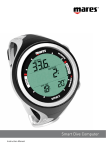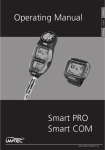Download Suunto t4 User's Manual
Transcript
EN | FR | DE | ES | IT | NL | FI | SV Training / Speed and Distance mode Time mode Logbook and coach Starts and stops the stopwatch Total of all training Resets the stopwatch c 2 se Switches between the modes Shortcuts Backlight Switches between the modes Shortcuts 2 sec Enters and exits the Settings and other submodes Backlight EN WELCOME Congratulations on choosing Suunto t4 as your personal training advisor. The Suunto t4 is a high-precision heart rate monitor designed to make your training as efficient and enjoyable as possible. Suunto t4 features the unique Suunto Coach function that knows exactly what is needed to reach your personal training goals. The Coach recommends the ideal workout sessions based on your current fitness level, your day-by-day situation, and the guidelines of the American College of Sports Medicine. Find more information on Suunto Coach in Section 2.4 Suunto t4 also displays Training Effect, an intelligent measure that tells you in real time how much the workout is improving your condition (see Section 2.3). Training Effect gives you the freedom to work-out without pre-set heart rate (HR) zones and ensures that every workout you do takes you closer to your targets, even if you dont follow the Coachs recommendations. Speed and distance data is available with optional Suunto PODs, wirelessly and without interference, through digital transmission. This users guide is here to help you get the most out of your training with Suunto t4. Please read through it to make using your new Suunto t4 even more productive. 1. Getting started ........................................................................... 5 1.1. Setting up Suunto t4 ............................................................... 6 1.2. Activity class (act class) ........................................................... 6 1.3. Suunto t4 at a glance .............................................................. 8 1.3.1. Time mode ................................................................... 10 1.3.2. Training mode ............................................................... 12 1.3.3. Speed and Distance mode ................................................. 13 1.3.4. Settings ....................................................................... 13 2. Before training .......................................................................... 17 2.1. The heart rate transmitter belt and speed and distance PODs .............. 17 2.1.1. Putting on the heart rate transmitter belt ................................. 17 2.1.2. Wireless speed and distance PODs ...................................... 19 2.2. Settings ............................................................................ 19 2.2.1. Time mode settings ......................................................... 19 2.2.2. Training mode settings ..................................................... 21 2.2.3. Speed and Distance mode settings ....................................... 24 2.3. Training Effect ..................................................................... 26 2.4. Suunto Coach ..................................................................... 28 2.4.1. Initial set-up .................................................................. 29 2.4.2. The training program ....................................................... 29 2.4.3. Training sessions ............................................................ 30 2.4.4. Automatic program adaptation ............................................ 31 3. Training .................................................................................. 32 3.1. Following a training program .................................................... 32 2 3.2. Manually adjusting your training program ...................................... 3.3. Training without set targets ...................................................... 3.4. Using the speed and distance displays ........................................ 4. After training ............................................................................ 4.1. Training Logbook ................................................................. 4.2. Training Totals ..................................................................... 4.3. Suunto Training World ........................................................... 5. Care and maintenance ................................................................ 5.1. General instructions .............................................................. 5.2. Water resistance .................................................................. 5.3. Replacing the battery ............................................................. 5.3.1. Replacing the battery of the Suunto t4 ................................... 5.3.2. Replacing the battery of the heart rate belt .............................. 6. Technical specifications ............................................................... 7. Intellectual property .................................................................... 7.1. Copyright .......................................................................... 7.2. Trademark ......................................................................... 7.3. Patent notice ...................................................................... 8. Disclaimers .............................................................................. 8.1. User's responsibility .............................................................. 8.2. Warnings ........................................................................... 8.3. CE .................................................................................. 8.4. ICES ................................................................................ 8.5. Limits of liability and ISO 9001 compliance .................................... 34 34 37 37 37 38 40 40 40 41 41 42 43 44 45 45 46 46 46 46 47 47 47 47 3 8.6. After sales service ................................................................ 48 8.7. FCC compliance .................................................................. 49 9. Disposal of the device ................................................................. 50 4 1. GETTING STARTED The buttons are named on the back of the device according to the functions they perform. However, in this user's guide the names are simplified as shown in the table below. Name on back of device Name in User's Guide + / lap UP Mode ENTER - / Light DOWN Alt / Back BACK Start / Stop START In Totals, Logbook, and Coach, small arrows on the screen indicate the buttons that you can navigate with. The buttons' functions depend on the length of the press. A short press is less than 1 second, and a long press is more than 2 seconds. Throughout this user's guide, the following symbols are used to indicate short and long presses. Short press 2 sec Long press 5 1.1. Setting up Suunto t4 When you press a button on your new Suunto t4 for the first time, you will be asked to define some basic settings. Use the UP and DOWN buttons to change the values, accept and move to the next item by pressing the ENTER button. The figure below shows you how to set up your device for the first time. Adjust with UP and DOWN buttons. Accept with ENTER button. Carry on setting up the time, date, units and personal settings. After this Suunto t4 will go into Time mode and will be ready for operation. NOTE Your maximum heart rate is determined using the formula 210 minus 0.65 times your age, which is automatically calculated from the date of birth that you enter. If you know your real maximum heart rate, you should use that instead of the calculated value. 1.2. Activity class (act class) Important: Your activity class is another one of the settings that you are asked to define when you set up your device for the first time. Your activity class is a measure of your current activity level. By entering your current activity class (1 - 10) into your Suunto t4, the device will be able to give much more accurate calorie consumption information. As the amount and/or intensity of your 6 physical activity increases, the device will automatically increase your activity class based on your recorded heart rate information. Your activity class will not be automatically decreased if, for example, you engage in less strenuous activity, but you should manually decrease your activity class if you think that it has decreased over time. See the table below for information on determining your activity class. Activity description Activity class No regular participation in Always avoid exertion, whenever possible. 0 recreational sports or heavy physical Walk for pleasure, routinely use stairs, occasionally 1 activity. exercise sufficiently to cause heavy breathing or perspiration. Regular participation in recreation or 10 - 60 minutes per week work requiring modest physical Over 1 hour per week activity, such as yard work, nordic walking or moderate-intensity cycling. 2 Regular participation in heavy physical exercise, such as running, aerobic classes or high-intensity cycling. Less than 30 minutes per week 4 30 - 60 minutes per week 5 1 - 3 hours per week 6 Over 3 hours per week 7 5 - 7 hours per week 7.5 7 - 9 hours per week 8 9 - 11 hours per week 8.5 11 - 13 hours per week 9 Endurance athlete (Regional level) Endurance athlete (National level) 3 7 Activity description Activity class Endurance athlete (International level) 13 - 15 hours per week 9.5 More than 15 hours per week 10 1.3. Suunto t4 at a glance Time mode Logbook Training mode Totals In Time mode you can: - view the time - go to log - go to Totals - go to Time settings - change shortcuts - connect to pc* 8 Speed and Distance mode (if paired with POD) In Training mode you can: - use the stopwatch - view your heart rate or Training Effect - set the Training Effect target - go to Training settings - change shortcuts In Speed and Distance mode you can: - view speed - view distance - set the Training Effect target - go to Speed and Distance settings - change shortcuts NOTE * In order to connect your device to a PC, an optional Suunto PC POD and Suunto software are required. In any of the above modes, a long press of the ENTER button will take you to that mode's Settings menu. In Time mode, a short press of the START button will take you to Logbook and a short press of the UP button accesses Totals. The figure below shows the functionality of each of these submodes. 9 Totals In Totals you can view the total values of your sessions for: - this week - last week - 6 last months Logbook In Logbook you can view your last 15 activities’: - Training Effect - duration - calories consumed - average heart rate - peak heart rate - time spent in and out of zones or limits Settings menu Each mode has its own settings menu where you can define the settings related to that mode. 1.3.1. Time mode Here you can see the functionality of the buttons used in Time mode. This will help you get started with using the basic functions of your Suunto t4. Additionally, you will find options for the shortcut, which is in the bottom line of the display. 10 GO TO LOGBOOK AND COACH CHANGE SHORTCUT: - DAY - DATE - DUAL TIME - CONNECT TO PC (LONG PRESS) GO TO TOTALS 2 sec GO TO TIME SETTINGS LIGHT The light The light can be activated in any mode at any point by short pressing the DOWN button. If you want to use the light in Settings, Logbook or Totals, the light must be activated before entering them. The alarm snooze Only the BACK button deactivates the alarm; pressing any other button activates the snooze function, which lasts for 5 minutes. The snooze function can be activated 12 times, after which the alarm will be deactivated until the set time the following day. Pressing the BACK button switches off the alarm. 11 1.3.2. Training mode Here you can see the basic functionality of the buttons used in Training mode as well as options for the shortcut, which is in the bottom line of the display. START/STOP LAP/RESET (LONG PRESS) 2 sec CHANGE SHORTCUT: - TRAINING EFFECT AND DURATION - TIME - CALORIE CONSUMPTION - AVERAGE HEART RATE LAP / INTERVAL TIME SPEED DISTANCE (IF CONNECTED TO POD) GO TO TRAINING SETTINGS LIGHT - CHANGE TRAINING EFFECT TARGET (LONG PRESS) The stopwatch is accessed by pressing the START button in Training mode and can be seen in the top row. The information from the training that you time with the stopwatch, such as heart rate and calorie consumption, is stored and can later be seen in Totals and Logbook. Therefore, you should activate the stopwatch, and ensure you have a heart rate reading, whenever you start a training session. Pressing the START/STOP button starts the stopwatch. Pressing the START/STOP button again, stops the stopwatch. While the stopwatch is running, you can take up to 99 lap times, the first 50 of which are stored in the memory, by pressing the UP button. 12 1.3.3. Speed and Distance mode The Speed and Distance mode is available when you have paired an optional speed and distance POD with your Suunto t4. Here you can see the functionality of the buttons used in Speed and Distance mode. START/STOP CHANGE SHORTCUT: - DAYTIME - AVG SPEED - DISTANCE - CHRONO - ALSO HR RELATED SHORTCUTS, IF HR BELT IS ON LAP/RESET (LONG PRESS) 2 sec GO TO SPEED AND DISTANCE SETTINGS LIGHT - CHANGE TRAINING EFFECT TARGET (LONG PRESS) 1.3.4. Settings Navigating in the Settings menus is very easy. Follow the position of the blinking empty box and you will know exactly where in the Settings menu you are. UP/ADJUST RIGHT/EXIT (LONG PRESS) LEFT DOWN/ADJUST Take a look at the following tables showing the different Settings and the items you can define in them. 13 Time mode settings Symbol 14 Setting Options Alarm Alarm: on/off Time Time: Dual time: hours/ minutes hours/ minutes/ seconds Date Date: year/ month/ day Personal Weight Height General Tones: on/off Heart rate: Height: bpm/ % cm/ft Alarm time: hour/min Activity class Max heart Sex rate Date of birth Weight: kg/lb Date: ddmm/ mmdd Time: 12h/24h Speed: km/h, mph, time/km, time/mile Training mode settings Symbol Setting Options Heart rate zones Zone 1: lower/ upper % Zone 2: upper % Zone 3: upper % Heart Heart Lower limit Upper rate limits rate limit limits: on/ off Alarm: on/off Intervals Interval 1: on/off Interval 1: Interval 2: Interval 2: minutes/ on/off minutes/ seconds seconds Pair a POD Pair: heart rate belt / Foot POD / Bike POD / GPS POD General Tones: on/off Heart rate: Height: bpm/ % cm/ft Weight: kg/lb Warm up: on/ off Warm up: minutes/ seconds Time: Date: 12h/24h ddmm/ mmdd Speed: km/h, mph, time/km, time/mile 15 Speed and Distance mode settings Symbol Setting Options Autolap Autolap: on/off Distance Speed Limits: on/off Lower limit Upper limit Calibrate Calibrate: Foot POD/ Bike POD Pair a POD Pair: heart rate belt / Foot POD / Bike POD / GPS POD General Tones: on/off Heart rate: bpm/ % Height: cm/ft Weight: kg/lb Time: 12h/24h Date: ddmm/ mmdd Speed: km/h, mph, time/km, time/mile Please refer to Section 2.2 Settings for more information on how to define the device's settings. 16 2. BEFORE TRAINING 2.1. The heart rate transmitter belt and speed and distance PODs 2.1.1. Putting on the heart rate transmitter belt The heart rate transmitter belt is an integral part of Suunto t4's functionality, so it's important that you know how to wear it correctly. We recommend that you wear the transmitter against your bare skin to ensure flawless operation. • The electrodes must be wet during the exercise. Raise the transmitter a little off your chest and moisten the electrode area on the side in contact with your skin. • Check that the wet electrode areas are firmly against your skin and that the logo is in a central upright position. • Enter Training mode. (Your heart rate will not be visible until you enter Training mode.) Whenever you enter Training mode or start the stopwatch, your Suunto t4 automatically searches for signals from a heart rate belt or paired speed and distance POD. 17 After switching to Training mode, Suunto t4 displays two bars while it is seeking the HR belt signal. Instead of your heart rate, "00" is shown in the center of the display if no heart rate belt is found. Once the device has found the signals, your heart rate or speed and distance information will be displayed in the center of the screen. NOTE For detailed instructions on how to pair and calibrate your optional speed and distance POD, please refer to the POD's own user's guide. Heart rate signal troubleshooting If you can't see a heart rate signal, or lose the signal, try these steps to fix the problem. • Exit and then re-enter Training mode. • Make sure that you are wearing the heart rate transmitter belt correctly. (See section 2.1.1.) • Ensure that the electrode area on the back of the belt is slightly wet. • If you have been using the belt for some time, the battery may need changing. For instructions on how to change the transmitter belt's battery, see section 5. 18 2.1.2. Wireless speed and distance PODs Optional wireless speed and distance PODs are light, easy-to-use, and accurate. Since the devices (Suunto Foot POD, Suunto Bike POD, and Suunto GPS POD) differ from each other, they come with separate user's guides, which you should read for more detailed information on their use. When you have paired and calibrated a speed and distance POD with your Suunto t4, you can take advantage of the Speed and Distance mode, as well as speed and distance-related control functions and information. 2.2. Settings Before you are able to make the most of your Suunto t4, it's worth taking some time to personalize it to suit your individual needs and preferences. If you have already defined the settings based on the information given in section 1, you can skip to section 3. 2.2.1. Time mode settings This figure shows how to enter the Time mode Settings menu and its different items. 2 sec NOTE Long press the ENTER button to switch between Time mode and settings. Use UP and DOWN buttons to toggle between the following time setting submenus: alarm, time, date, personal, general. Remember that you can see where you are within the Settings menu by following the flashing bar in the navigational aid. 19 Alarm settings In the Alarm menu, you can set the alarm on or off and set the alarm time. Accept the settings with a short press of the Enter button, which also moves you on to the next menu item. Time settings In the Time menu, you can set the time and dual time. Accept the settings with a short press of the Enter button, which also moves you on to the next menu item. Date settings In the Date menu, you can set the day, month, and year. Accept the settings with a short press of the Enter button, which also moves you on to the next menu item. Personal settings In the Personal menu, you can enter personal information such as your weight, height, activity class, maximum heart rate, gender, and date of birth. Accept the settings with a short press of the Enter button, which also moves you on to the next menu item. Adjust the weight setting with UP and DOWN buttons. Accept with ENTER button. Continue setting your height, activity class, maximum heart rate, sex and birth date. 20 NOTE See the table in Section 1.2, Activity class for information on activity class descriptions. General settings In the General menu, you can set the button tones on or off and choose the units and format the information is displayed in. Accept the settings with a short press of the Enter button. 2.2.2. Training mode settings This figure shows how to enter the Training mode Settings menu and its different items. 2 sec Long press the ENTER button in Training mode to enter Training settings menu. Use UP and DOWN buttons to toggle between the following Training setting submenus: heart rate zones, heart rate limits, intervals, pair a POD and general. Heart rate zone settings In the Heart Rate Zone menu, you can define the 3 heart rate zones and set the tones on or off. The 3 heart rate zones are useful in training as they record how much of your training is spent within specific heart rate zones, or if you want to give yourself a long enough warm-up, or keep your heart rate at an optimum level for fat burning. 21 After training, you can see how much of the session was spent in each zone. Each zone is a range of heart rates expressed as a percentage of your maximum heart rate (which is calculated based on the age you enter in the Personal settings menu). Accept the settings with a short press of the ENTER button, which also moves you on to the next menu item. The default heart rates for zones 1-3 are 60-70%, 70-80%, and 80-90% of your maximum heart rate, but if you are following a specially designed training program, enter the zone values that have been tailored towards your individual goals. The benefits of training in each default zone are shown in the table below. Heart rate zone Default setting Zone 1 (Fitness zone) 60 - 70% of maximum heart Improves your basic endurance, and helps you to recover from harder rate training sessions. Can also be used in weight control. Zone 2 (Aerobic zone) 70 - 80% of maximum heart Improves your aerobic capacity. This is the preferred zone if you are rate training for an endurance event. Zone 3 (Threshold Zone) 80 - 90% of maximum heart Improves your maximum aerobic capacity and lactate tolerance ability rate (anaerobic threshold) - meaning your maximum endurance will improve and you'll be able to fight fatigue better. NOTE 22 Main benefit The heart rate zone defaults follow the guidelines of the American College of Sports Medicine for exercise prescription. The average heart rate is also a useful measure during training where the heart rate levels vary a lot, such as biking in hilly terrain. In these cases, the target zone limits are less practical than the average heart rate. Heart rate limit settings In the Heart Rate Limit menu, you can set the heart rate limits on or off, define the upper and lower limits, and set the heart rate alarm on or off. You can set the heart rate limits to help you stay within a defined heart rate range, which you can set to match the goal of your training. While training, your real-time heart rate can be displayed in the center of the screen. If the average heart rate shortcut is selected, your real-time average heart rate per lap is displayed in the bottom row as either beats per minute or a percentage of your maximum heart rate. In the Settings menu, you can set alarms to notify you when you go above your set upper heart rate or below the set lower heart rate. Upper limit Lower limit Target heart rate When the Limit alarm is on, Suunto t4 gives you an alarm when your heart rate rises above the upper limit or drops below the lower limit. The alarm continues until you return to your target heart rate range. By checking your average heart rate you can adjust your training intensity to make sure the session is as effective as possible. 23 Intervals settings In the Intervals menu, you can set interval 1 and 2 on or off and define their times. You can also set the warm-up timer on or off and define its time. Accept the settings with a short press of the Enter button, which also moves you on to the next menu item. Pair a POD settings In the Pair a POD menu, you can pair your Suunto t4 with your heart rate transmitter belt, Suunto PC POD, Suunto Foot POD, Suunto Bike POD or Suunto GPS POD. Select the POD you want to pair using UP and DOWN buttons. Accept with the ENTER button then turn on the POD you want to pair. NOTE After pairing, enter Time mode and re-enter Training mode to view the POD's readings. General settings See Section 2.2.1 Time mode settings for information on General settings. 2.2.3. Speed and Distance mode settings To recap, this figure shows how to enter the Speed and Distance mode settings menu and its different items. 24 2 sec Long press the ENTER button in Speed and Distance mode to enter Speed and Distance settings menu. Use UP and DOWN buttons to toggle between the following Speed and Distance setting submenus: autolap, speed, calibrate, pair a POD and general. Autolap settings In the Autolap menu, you can set the autolap function on or off and set the distance for each lap. When autolap is set on, and you have a paired speed and distance POD, the device beeps and shows total distance, average lap speed, and lap time for 5 seconds with each lap. Speed settings In the Speed menu, you can set the speed limit on or off and define the upper and lower speed limits. Calibrate settings In the Calibrate menu, you can calibrate your Suunto Foot POD or Suunto Bike POD. An alternative way of calibrating your POD is to run or cycle a known distance, say 10 km, using the POD. If you do not reset the stopwatch after completing the distance, you can correct the distance shown, for example 9.6 km, from the settings. The device will then update the calibration value accordingly. The GPS POD is also listed in the Calibrate menu but the calibration has no effect on the GPS POD measurements. You will need this calibration only if you have, for instance, two Bike PODs for different bikes. You can then pair one of them as GPS POD and use the calibration in the same way as you normally would with Bike POD. 25 Pair a POD settings See Section 2.2.2 Training mode settings for information on Pair a POD settings. General settings See Section 2.2.1 Time mode settings for information on General settings. 2.3. Training Effect A unique feature of Suunto t4 is its ability to record and display Training Effect. Training Effect (TE) shows the effect of a workout on your aerobic fitness on a simple one-to-five scale. For the first time, you will know in real time how much your workout is really improving your fitness level. With Training Effect, you can ensure that your workouts always give the intended result. Please note the difference between training zone (temporary training intensity) and Training Effect (total load of a workout). In zone training, you try to keep your heart rate at a certain level throughout the whole workout, whereas for Training Effect it is enough just to reach the desired TE value once during the workout. Measured TE Description Result of the workout 1.0 - 1.9 Minor TE Enhances recovery (short workout) or develops base endurance (over 1 hour session). Ideal for fat burning. Does not improve maximal performance. 2.0 - 2.9 Maintaining TE Maintains aerobic fitness. Builds base for harder training in the future. Does little to improve maximal performance. 3.0 - 3.9 Improving TE Improves aerobic fitness if repeated 2–4 times a week. No special recovery requirements. 26 4.0 - 4.9 Highly improving TE Rapidly improves aerobic fitness if repeated 1–2 times a week. A few easier exercise sessions (TE 1–2) needed for recovery. 5.0 Over-reaching TE Dramatic increase in aerobic fitness if adequate recovery is allowed afterwards. High demand for recovery. Increased risk of overtraining if repeated too often. When monitoring your Training Effect, you no longer need to stay within pre-defined heart rate zones because the TE shows the actual result of the workout regardless of what your exact heart rate is. This gives you freedom from the zone alarms while still reaching the desired result. Suunto t4 shows the Training Effect in two ways. The lower right side of the display shows it as a graph. It can also be shown as a number in the center of the screen instead of the heart rate reading. The TE of each workout is defined by the highest number (from 1.1 to 5.0) reached during the workout. The peak TE reached stays visible on the graph. If you want to further increase the effect after a lower intensity period, you need to work-out harder to push the peak higher. Long pressing the BACK button switches between heart rate and real-time Training Effect. TE can be shown in the center instead of heart rate. ec TE graph + scale 2s This shortcut shows how much time you still have to the next training effect level. In this example, you need to continue 10 minutes at the current intensity to reach TE 3.2. If you continue your workout after reaching the target, the bottom row automatically starts showing remaining time to the next TE level, in this case 3.4. 27 Training Effect reached so far in the workout: 3.8 (Improving) Peak level. If there has been a period of lower intensity, your current level may be lower. To reach higher TE than 3.8 from this workout, you need to increase the intensity so that this graph pushes the peak mark higher. Bottom row: Next TE level is 4.0 but you can not reach it with the current intensity. (Time indicator -:-- means that you have to increase intensity to reach the target.) To find out more about Training Effect, and how to use it to improve your training, please download Suunto Training Guidebook from www.suunto.com/training. Heart beat analysis technology producing Training Effect is provided and supported by Firstbeat Technologies Ltd. 2.4. Suunto Coach The Suunto Coach is your personal training advisor. It generates an ideal training program for the next 5 days, based on your current fitness level and your past week’s workouts. The Coach follows the guidelines of the American College of Sport Medicine for exercise prescriptions, ensuring that your training is safe and effective in taking you towards your training goals. The Coach can be entered by short pressing the START button in Logbook. 28 2.4.1. Initial set-up The only initial information that Suunto Coach needs is your current activity class. This is asked when you set up your device for the first time, see section 1.1. You can also adjust it in the Personal menu of Time mode settings, see section 2.2.1. Even if your activity class is not exactly right, the Coach finds the right level in a few weeks, once you start using your Suunto t4. For the Coach to function correctly, it is important that you always record your workouts with your Suunto t4. 2.4.2. The training program The program consists of six different levels: Initial level for beginners, four improvement levels with increasing training volume and intensity, and a maintenance level designed for active endurance sports participants. The Coach defines the starting level of your training program based on your activity class. From the starting level, the Coach takes you toward improved performance, fully adapting to your daily situation. Program level Level description Times/ week Duration of workout Total/ week 1 Initial stage 3 25 - 35 mins 1.5 hours 2 Improvement 1 3 25 - 35 mins 1.5 hours 29 Program level Level description Times/ week Duration of workout Total/ week 3 Improvement 2 4 30 - 60 mins 3 hours 4 Improvement 3 4 45 - 60 mins 3.5 hours 5 Improvement 4 5 45 - 75 mins 6 hours 6 Maintenance 4-5 30 - 75 mins 3.5 - 6 hours The coach recognizes when you have reached a sufficient fitness level to move to the next program level. To ensure safe and continuous progress, there is a minimum time of four weeks for each level. Note that even though they are closely linked to each other, the training program level is different from your activity class. Both your activity class and program level are shown when you enter the Coach display. 2.4.3. Training sessions The Coach generates a training program for the next 5 days. The program maintains a balance between workout and rest, and a variation between easy and hard, long and short workouts for the best progress. Each workout has a target Training Effect and a recommended duration. The Training Effect targets for the next 5 days are shown as a bar graph in the center of the Coach display. To check the exact recommendations for the next days, you can move with UP and DOWN buttons. 30 The Coach display alternates every 2 seconds between the Training Effect target and the duration. To activate the recommendation as your target workout, press the ENTER button and then press START to begin training. Your Suunto t4 starts guiding you to the target Training Effect in the recommended time. See more information about the guidance available during your workout in Section 3. Although the coach gives recommendations about intensity and duration, the sessions are not tightly restricted. To achieve each session's goal you can choose to train at a higher or lower intensity or for more or less time. However, it is worth remembering that improving fitness requires patience, and the recommendations given by the Coach are optimized for progress, based on your own training history. 2.4.4. Automatic program adaptation The Coach automatically updates the training program to respond to your actual training. It notices if the Training Effect of your previous workouts was above or below target and modifies the goal of the next session accordingly. If you decide to do something else instead of the recommended workout, or even have a longer break in your training, the program continues to adapt. 31 Following the advice of the Suunto Coach, or at least checking its recommendations regularly, ensures that your training has an optimal rhythm and intensity in all situations. The Coach gives you the confidence that you are training correctly to reach your training goals in a safe and systematic way, and makes your training more interesting. Enjoy using it! Heart beat analysis technology producing the adaptive training program of Suunto Coach is provided and supported by Firstbeat Technologies Ltd. 3. TRAINING Once you have your Suunto t4 set up as you like it, it's time to get out and start training. For detailed information on training and tips on how to maximize its effectiveness, download Suunto Training Guidebook from www.suunto.com/training. There are four alternative ways to use your Suunto t4 in training: following a training program, manually adjusting your training program, training without targets, and using the speed and distance displays. 3.1. Following a training program If you are following a training program designed for you by Suunto t4's Coach function, the device will provide you with guidance to help you reach your Training Effect target in the recommended time while training. Short press the ENTER button in Coach and you will enter Training mode. Pressing the START button then initiates a guided training session. 32 Press the START button to start the guided training. Press ENTER to set guided training session – this moves you to the Training mode. The stopwatch and the timer of the training start – keeping you informed on how long you should be exercising to reach target Training Effect. In Training mode, the following information and guidance will be provided if your training intensity is too low or too high. If your pace is too fast, an arrow pointing down will appear telling you to slow down. If your pace is too slow, an arrow pointing up will appear telling you to speed up. 33 3.2. Manually adjusting your training program You can increase the Training Effect target by long pressing the DOWN button while the Training Effect shortcut is displayed. This automatically updates the recommended duration of the session. Long press the DOWN button to increase the Training Effect target. 2s ec When the stopwatch has been reset, you can change the target time by long pressing the UP button. c 2 se Long press the UP button when the Training Effect shortcut is chosen and the stopwatch has been reset, to increase the target time. 3.3. Training without set targets The stopwatch is activated by short pressing the START button in Training mode. It can be seen in the top row in Training mode. The information from the training that you time with the stopwatch, such as heart rate and calorie consumption, is stored and can later be seen in Totals and Logbook. Therefore, you should activate the stopwatch, and ensure you have a heart rate reading, whenever you start a training session. 34 Pressing the START/STOP button starts the stopwatch. Pressing the START/STOP button again, stops the stopwatch. Pressing the UP button, when the stopwatch is running, stores the split time and displays it in the top row of the Suunto t4. It also displays the average heart rate and shows the lap time. After 3 seconds, the display jumps back to the stopwatch. This number indicates the ongoing lap. While training, the stopwatch displays either the real-time Training Effect or heart rate in the center of the screen. You can switch between the two by long pressing the BACK button. The information that is displayed while the stopwatch is running depends on the device's settings as well as on whether there is a speed and distance POD connected. The default shortcut, which appears on the bottom row of the display, is the Training Effect target. 35 Pressing the BACK button changes the shortcut at the bottom of the display. Some shortcuts are only available when connected to speed and distance POD. When the stopwatch has been stopped, you can reset it by long pressing the UP button, as shown in the figure below. ec 2s Long pressing the UP button when the stopwatch is stopped resets the stopwatch. If your peak heart rate in the most recent session exceeded the maximum heart rate defined in Personal Settings, Suunto t4 will ask if you want to update your maximum heart rate value after resetting the stopwatch. If you want to update your maximum heart rate, press the DOWN button. Pressing the BACK button takes you back to Training mode without updating your maximum heart rate. 36 3.4. Using the speed and distance displays While training, the Speed and Distance mode provides additional information to help you monitor and adjust your training. The top row displays distance information, the center row displays speed information, (in whichever format was chosen in General settings), and the bottom row displays different information depending on the shortcut selected. Pressing the BACK button changes the shortcut at the bottom of the display. NOTE If Autolap is set off, the average speed shown is the average speed from the start of the previous lap and the lap time is the time from the start of the last lap. 4. AFTER TRAINING Once you have finished your training, your Suunto t4 can provide you with detailed information on your performance. In this section, we'll look at the Totals and Logbook functions, as well as Suunto's online training community, www.suunto.com/training. 4.1. Training Logbook Immediately after finishing your training, one of the first things you'll want to do is review all the data recorded during the session. You can see your Training Effect, peak heart rate, average heart rate, how many calories you burned, speed and distance information (if using an optional speed 37 or distance POD) and more in the Logbook submode. The Logbook can be accessed by short pressing the START button in Time mode. You can use the DOWN, UP, ENTER and BACK buttons to navigate in the menu. Press the ENTER button to scroll through the logs. Use the UP and DOWN buttons to view the summary of a particular log: Training Effect, average and peak heart rate etc. Move back in the summary using the BACK button. Depending whether you had set the heart rate limits or heart rate zones on or off during the training, the Logbook will display information relating to either heart rate zones or heart rate limits, or neither if both were turned off or your Training Effect was less than 1.1. The logbook stores all the information from your last 15 training sessions. After 15 logs have been saved, the latest one will overwrite the oldest one. You cannot delete or modify logs in the memory. If you are interested in more detailed, long-term analysis, you might be interested in Suunto's PC software. You can use it to view in-depth figures, statistics, and graphical representations of all the training sessions performed with your Suunto t4. Please see www.suunto.com/training for more details. 4.2. Training Totals In addition to detailed information on your last 15 training sessions, Suunto t4 stores all the accumulated data recorded this week (Monday - Sunday), last week, and for the last 6 months. This information can be seen in the Totals submode, which is accessed by short pressing the UP button in Time mode. 38 When in the Totals submode, use the UP and DOWN buttons to choose the period you wish the view. The ENTER and BACK buttons are used to view the different totals, for example Training Effect total, calorie consumption totals, and distance totals. The figure below shows how to navigate within the Totals menu. Press the UP button in Time mode to view the totals of your training. Long press ENTER button to exit the Totals. Pressing the ENTER button takes you through your training totals for this week: number of workouts, training time, calories etc. In each display, you can use the UP and DOWN buttons to change between the view for this week, last week, and for each month for the past 6 months. Press the BACK button to return to the previous display. NOTE In the Week view of the Training Effect totals, as in the above figure, each dot represents 15 minutes of training. In the Month view, each dot represents one hour of training. Once you have reviewed your data, you can exit Totals by long pressing either the ENTER or BACK button. 39 4.3. Suunto Training World Suunto Training World, Suunto's training-specific Web site, is dedicated to helping athletes and fitness enthusiasts at all levels achieve their goals. You'll find this site the perfect training partner for running, cycling, aerobics, spinning, walking and the whole range of endurance and team sports. Whether you're working toward a marathon, or aiming for weight loss and a healthy heart, Suunto Training World is a valuable resource for tips, news and inspiration. Take a tour of the site at www.suunto.com/training. Learn about new Suunto training products, gather training tips, participate in discussions, keep abreast of training news, and motivate yourself with the stories of Suunto Ambassadors. 5. CARE AND MAINTENANCE Your Suunto t4 is a precision instrument. By following a few common sense points, you can maximize the life of your device. If your Suunto t4 does require servicing, you should take it to your nearest Suunto representative. This section also describes the steps to follow when replacing the battery in both your Suunto t4 and the transmitter belt. 5.1. General instructions • • • • • 40 Only perform the procedures described in this user's guide. Never attempt to disassemble or service your Suunto t4. Always protect your Suunto t4 from shocks, hard and sharp objects, extreme heat and prolonged exposure to direct sunlight. If not in use, store your Suunto t4 in a clean and dry environment at room temperature. In order to prevent the face from becoming scratched, the device should not be stored in the bottom of a bag or other place where it could come into contact with hard objects. • • You can wipe your Suunto t4 clean with a cloth lightly moistened with warm water. If there are stubborn stains or marks, you can apply mild soap to the area. Do not expose your Suunto t4 to strong chemicals, such as gasoline, cleaning solvents, acetone, alcohol, insect repellents, adhesives and paint, as they will damage the unit’s seals, case and finish. 5.2. Water resistance Your Suunto t4 is water resistant up to 30 m/100 ft and the transmitter belt to 20m/66ft according to ISO 2281 standard (www.iso.ch). This means that you can use your Suunto t4 for swimming and other water sports activities but you must not use it for scuba diving or freediving. To maintain water resistance and to ensure that the warranty remains valid, we strongly recommend that you have all service, except for battery change, performed by authorized Suunto service personnel. NOTE Never push the buttons while swimming or in contact with water. Pressing the buttons while the unit is submerged could cause the unit to malfunction. NOTE Even though both the Suunto t4 and the transmitter belt are water-resistant, the radio signal does not carry in water, which makes the communication between Suunto t4 and the transmitter belt impossible. 5.3. Replacing the battery Your Suunto t4 operates on a 3-Volt lithium cell, type: CR 2032. The life expectancy is approximately 12 months of operation with an average of 4 hours of training a week. The higher your average amount of training hours a week, the shorter the battery's life expectancy will be. 41 NOTE To reduce the risk of fire or burns, do not crush, puncture or dispose of used batteries in fire or water. Only replace them with manufacturerspecified batteries. Recycle or dispose of used batteries properly. 5.3.1. Replacing the battery of the Suunto t4 To replace the battery: 1. Use a coin to open the battery compartment on the back of your device. Ensure that the O ring and all surfaces are clean and dry. 2. Remove the old battery. 3. Place the new battery into the battery compartment with the positive side facing up. 4. Slide the battery gently against the contact plate on the side, ensuring that it does not break or bend out of place. 5. When replacing the cover, rotate it carefully counter-clockwise with your thumb in order to align the threads. The cover should rotate easily at first without having to use force. If you have to use force right at the start, the threads are misaligned and the threads may be damaged. 6. Perform the final tightening with a suitably sized coin. NOTE The markings on the cover may be left unaligned once the cover has been tightened. If the old cover is undamaged, it does not need to be replaced. NOTE If the threads of the battery compartment cover are damaged, please send your device to an authorized Suunto representative for service. 42 NOTE Replace the battery with extreme care to ensure that your Suunto t4 remains water resistant. Careless battery replacement may void the warranty. NOTE Heavy use of the backlight will significantly reduce battery life. 5.3.2. Replacing the battery of the heart rate belt The average expected battery life of the transmitter belt is 300 hours of use in ideal operating temperatures. If your Suunto t4 does not receive a signal when the transmitter belt is active, you might need to replace the battery. 1. Use a coin to open the battery compartment cover on the backside of the transmitter belt. Ensure that the O ring and all surfaces are clean and dry. Do not stretch the O ring. 2. Remove the old battery. 3. Place the new battery into the battery compartment with the positive side facing up. 4. With the O ring in the correct position, replace the battery compartment cover. 43 NOTE We recommend that you replace the battery cover and the O ring simultaneously with the battery to ensure that the transmitter remains clean and water-resistant. Replacement covers are available with replacement batteries. NOTE Battery covers of the transmitter belt and Suunto t4 are not interchangeable. 6. TECHNICAL SPECIFICATIONS General. • Operating temperature: -20°C to +60°C/-5°F to +140°F • Storage temperature: -30°C to +60°C/-22°F to +140°F • Weight: 45 g/50 g/65 g (depending on the strap) • Water-resistance: 30 m/100 ft (ISO 2281) • User replaceable battery CR2032 44 Calendar clock. • Resolution: 1 s. Programmed until 2050 Stopwatch. • Stopwatch range: 99 hours. Lap time range: 99 hours. Lap/split times: 50/log • Resolution: 0.1 s Heart rate data. • Display range: 30 - 240 bpm • Heart rate limits: 30 - 240 bpm • Maximum heart rate for percentage display: 240 bpm Transmitter belt. • Water-resistance: 20 m/66 ft (ISO 2281) • Weight: 61 g • Frequency: 2.465 GHz Suunto ANT compatible • Transmission range: Up to 10 m/30 ft • User-replaceable battery: CR2032 7. INTELLECTUAL PROPERTY 7.1. Copyright This publication and its contents are proprietary to Suunto Oy and are intended solely for the use of its clients to obtain knowledge and key information regarding the operation of Suunto t4 products. Its contents shall not be used or distributed for any other purpose and/or otherwise communicated, disclosed or reproduced without the prior written consent of Suunto Oy. 45 While we have taken great care to ensure that information contained in this documentation is both comprehensive and accurate, no warranty of accuracy is expressed or implied. Its content is subject to change at any time without notice. The latest version of this documentation can always be downloaded at www.suunto.com. 7.2. Trademark Suunto, Suunto t4, Replacing Luck, their logos, and other Suunto brand trademarks and made names are registered or unregistered trademarks of Suunto Oy. All rights are reserved. Firstbeat & Analyzed by Firstbeat are registered or unregistered trademarks of Firstbeat Technologies Ltd. All rights reserved. 7.3. Patent notice This product is protected by the following patents and patent applications and their corresponding national rights: US 11/432,380, US 11/181,836, US 11/169712, FI 20065147, US 11/154,444, US 10/523,156, US 10/515,170 and EU Design 000528005-0001/000528005-0010. 8. DISCLAIMERS 8.1. User's responsibility This instrument is intended for recreational use only. Suuntot4 must not be used as a substitute for obtaining measurements that require professional or laboratory-quality precision. 46 8.2. Warnings If you have a pacemaker, defibrillator, or other implanted electronic device, you use the transmitter belt at your own risk. Before you start using a transmitter belt, we recommend an exercise test under a doctor’s supervision. This will ensure the safety and reliability of the pacemaker and transmitter belt when used simultaneously. Exercise may include some risk, especially for those who have been sedentary. We strongly advise consulting your doctor prior to beginning a regular exercise program. 8.3. CE The CE mark is used to mark conformity with the European Union EMC directives 89/336/EEC and 99/5/ EEC. 8.4. ICES This Class [B] digital apparatus complies with Canadian ICES-003. 8.5. Limits of liability and ISO 9001 compliance If this product should fail due to defects in materials or workmanship, Suunto Oy will, at its sole option, repair or replace it with new or rebuilt parts, free of charge, for two (2) years from the date of its purchase. This warranty is only extended to the original purchaser and only covers failures due to defects in materials and workmanship that occur during normal use while in the period of the warranty. It does not cover battery, battery replacement, damage or failures resulting from accident, misuse, neglect, mishandling, alteration or modifications of the product, or any failure caused by operation of the product outside the scope of its published specifications, or any causes not covered by this warranty. 47 There are no express warranties except as listed above. Suunto Oy and its subsidiaries shall in no event be liable for any incidental or consequential damages arising from the use of or inability to use the product. Suunto Oy and its subsidiaries do not assume any responsibility for losses or claims by third parties that may arise through the use of this device. Suunto's Quality Assurance System is certified by Det Norske Veritas to be ISO 9001 compliant in all Suunto Oy's operations (Quality Certificate No. 96-HEL-AQ-220). 8.6. After sales service If a claim under warranty appears to be necessary, return the product, freight prepaid, to your Suunto representative who is responsible for having your product repaired or replaced. Include your name, address, proof of purchase and/or service registration card, as required in your country. The claim will be honored and the product repaired or replaced at no charge and returned in what your Suunto representative determines a reasonable amount of time, provided that all necessary parts are in stock. All repairs that are not covered under the terms of this warranty will be made at the owner's expense. This warranty is non-transferable from the original owner. Suunto's heart rate monitors can be registered online at www.suunto.com. Registering your unit makes it quicker and easier for us to help you if you ever need to send your product for servicing, or if you need information about using your unit from our Global Help Desk. 48 8.7. FCC compliance This device complies with Part 15 of the FCC limits for class B digital devices. This equipment generates, uses, and can radiate radio frequency energy and, if not installed or used in accordance with the instructions, may cause harmful interference to radio communications. There is no guarantee that interference will not occur in a particular instance. If this equipment does cause harmful interference to other equipment, try to correct the problem by relocating the equipment. Consult an authorized Suunto representative or other qualified service technician if you cannot correct the problem. Operation is subject to the following conditions: 1. This device cannot cause harmful interference. 2. This device must accept any interference received, including interference that may cause undesired operation. Repairs should be made by authorized Suunto service personnel. Unauthorized repairs will void the warranty. Tested to comply with FCC standards. For home or office use. FCC WARNING: Changes or modifications not expressly approved by Suunto Oy could void your authority to operate this device under FCC regulations. 49 9. DISPOSAL OF THE DEVICE Please dispose of the device in an appropriate way, treating it as electronic waste. Do not throw it in the garbage. If you wish, you may return the device to your nearest Suunto representative. 50 Suunto's heart rate monitors can be registered online at www.suunto.com. All warranties are limited and are subject to the restrictions given in the instruction manual. This warranty does not cover the damage to the product resulting from improper usage, improper maintenance, neglect of care, alteration, improper battery replacement or unauthorized repair. This product is warranted to be free of defects in material and/or workmanship to the original owner for the above noted period (does not include battery life). Keep a copy of the original purchase receipt and make sure to get this warranty card stamped at the place of purchase. The warranty originates from the date of purchase. TWO YEAR WARRANTY Model of heart rate monitor: Serial number: Store Country Place of purchase/Store name Date of purchase Store City Store stamp with date of purchase Name City E-mail Country Address Telephone Signature CUSTOMER SERVICE CONTACTS COORDONNÉES DU SERVICE CLIENTS, KUNDENDIENSTE, DATOS DE CONTACTO DE ATENCION AL CLIENTE, NUMERI UTILI PER IL SERVIZIO CLIENTI, KLANTENSERVICE, ASIAKASPALVELUN YHTEYSTIEDOT, KUNDSERVICE, KONTAKTER Global Help Desk Suunto USA Phone Canada Phone Suunto website +358 2 284 11 60 +1 (800) 543-9124 +1 (800) 776-7770 www.suunto.com COPYRIGHT This publication and its contents are proprietary to Suunto Oy. Suunto, Wristop Computer, Suunto t4, Replacing Luck and their logos are registered or unregistered trademarks of Suunto Oy. All rights reserved. While we have taken great care to ensure that information contained in this documentation is both comprehensive and accurate, no warranty of accuracy is expressed or implied. Its content is subject to change at any time without notice. Suunto Oy 5/2006, 6/2006





































































